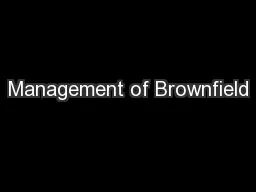PPT-Larry Brownfield, CPO, OHE
Author : giovanna-bartolotta | Published Date : 2019-11-19
Larry Brownfield CPO OHE KOA Inc Cash Management Course Objectives Identify procedures to help reduce your risk related to cash management 2 Describe why separation
Presentation Embed Code
Download Presentation
Download Presentation The PPT/PDF document "Larry Brownfield, CPO, OHE" is the property of its rightful owner. Permission is granted to download and print the materials on this website for personal, non-commercial use only, and to display it on your personal computer provided you do not modify the materials and that you retain all copyright notices contained in the materials. By downloading content from our website, you accept the terms of this agreement.
Larry Brownfield, CPO, OHE: Transcript
Download Rules Of Document
"Larry Brownfield, CPO, OHE"The content belongs to its owner. You may download and print it for personal use, without modification, and keep all copyright notices. By downloading, you agree to these terms.
Related Documents














